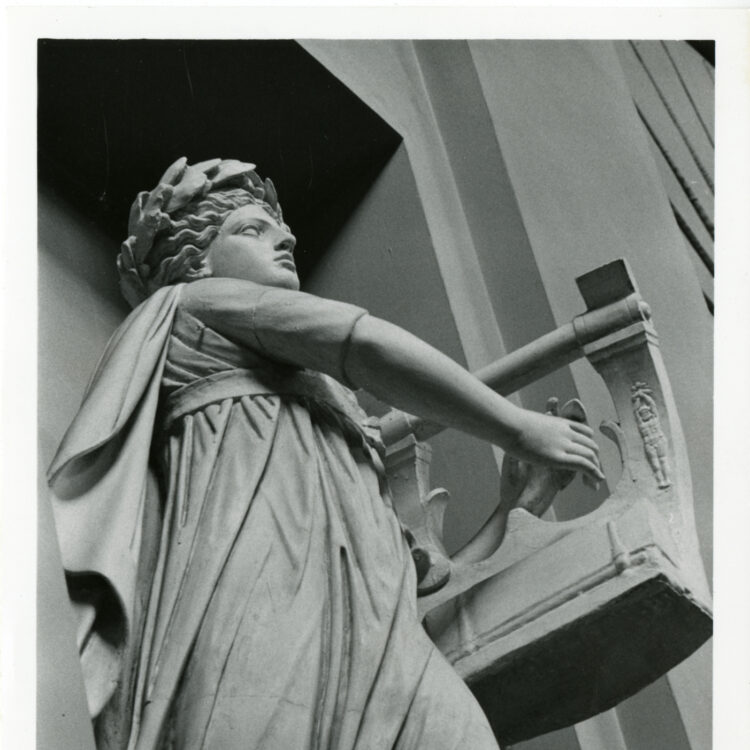Casts of Characters at Symphony Hall
The 16 replicas of Greek and Roman statues placed in the niches around the walls of Symphony Hall are related in some way to music, art, or literature. The statues reflect the words of 19th-century Bostonian William Tudor, who dubbed “Boston, the Athens of America.” When Symphony Hall was built in 1900, Bostonians felt a strong connection between their city and Athens during its Golden Age.
The statues are also important as part of the acoustical treatment of the Hall, providing uneven surfaces to diffuse sound waves. Symphony Hall appears to be unique among major concert halls in its use of classical sculpture in the interior of the concert hall.
The statues were cast by P.P. Caproni and Brother, Boston, makers of plaster reproductions for public buildings and art schools.

Apollo Citharoedus (Vatican Museum, Rome)
Photograph by Jet Commercial Photographers
Creating the Statues
Catalog of Plaster Reproductions, P.P. Caproni and Brother, 1911
The Caproni Gallery became the leading art gallery of its kind in the world, making their reproductions available to museums, schools, and private connoisseurs through an illustrated catalogue which listed over 2500 casts. After Caproni’s death in 1928, ownership changed hands several times until 1971 when Lino Giust bought what remained of the building and its contents and set out to preserve and organize the inventory. The sculptor Robert Shure, a student of Arcangelo Casieri and Adio DiBiccari, and personal friend of Lino Giust, purchased the Giust Gallery in 1992. The catalog page depicted here shows Lemnian Athena; Mnemosyne, Mother of the Muses; Seated Anacreon; Germanicos; and Dancing Satyr, copies of which are in Symphony Hall.
Gift of Patricia Crandall
Photograph of the Caproni Gallery on Washington Street
In 1900, Pietro Caproni (1862-1928) built the Caproni Gallery building at 1920 Washington Street in Boston to cast and house his reproductions of sculptures from major European museums.
Gift of Patricia Crandall
Sample of mold used to create the side of Diana of Versailles' face
Diana the Huntress, or Artemis of the Chase, is the Greek goddess of hunting and the twin sister of Apollo. The ancient Roman statue resides in the Hall of Antiquities in the Louvre Museum. It is a 1st or 2nd century AD copy of a lost Greek bronze sculpture from ca. 325 BC. Symphony Hall’s Diana is a full-size reproduction of that sculpture, created from molds taken from the same original first copy of the Louvre. Sculpture casts are meticulously created from plaster piece molds.
Courtesy Robert and Kathleen Shure of Skylight Studios, the Giust Gallery, and the Caproni Collection
Sculpting tools
Courtesy Robert and Kathleen Shure of Skylight Studios, the Giust Gallery, and the Caproni Collection
Filling the Niches
Interior of Boston Music Hall showing Apollo Belvedere in a niche at the rear of the hall
Apollo Belvedere, moved from the Music Hall to Symphony Hall in 1900, was the only statue in place for Symphony Hall’s opening concert, October 15, 1900.
Photograph by A.H. Rickards
Interior view of Symphony Hall, ca. 1901, showing vacant niches and two with statues
When Symphony Hall opened in 1900, one notable feature was the emptiness of all but one of the 16 niches that lined the side and rear walls of the auditorium above the second balcony. While part of the original decorative and acoustical scheme, the statues were regarded as frivolous by the directors of the “New Boston Music Hall.” Apollo Citharoedus (left) and Euripides (right) were placed in their niches halfway through Symphony Hall’s inaugural season but were later moved to other positions.
Photographer unknown
October 9, 1902 article appearing in the Boston Herald
The remainder of the casts of Greek and Roman statues appeared over the next few years and were donated to Symphony Hall by a committee of 200 anonymous symphony-goers, led by Mrs. John W. Elliott.
Faun with Infant Bacchus (Naples Museum)
When Bacchus (Dionysus) was an infant, his father, Zeus, entrusted him to the nymphs and fauns, mythical creatures of the woodlands, and to the Muses, goddesses who presided over the arts, music, and literature.
Photographer unknown
Statues along the back left wall of Symphony Hall
Left to right: Seated Anacreon (Villa Borghese, Rome; Euripedes (Vatican Museum, Rome); Diana of Versailles (Louvre Museum, Paris)
Photograph by Photography Incorporate









